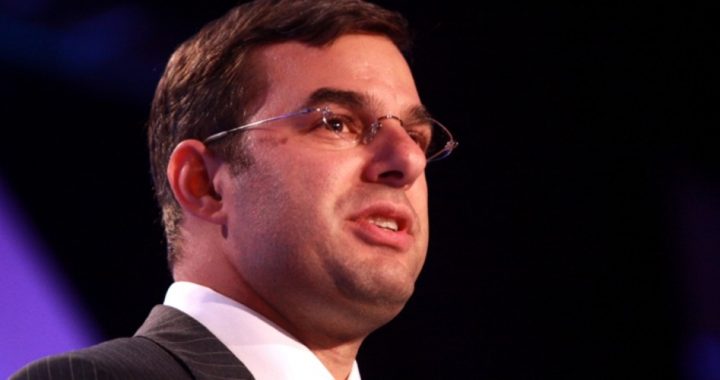
“Bring it on. I’ll always stand up for liberty, the Constitution & Americans of every background,” retorted Representative Justin Amash (R-Mich.; shown) in response to the call by President Donald Trump’s social media director, Dan Scavino, Jr., that Amash be defeated in a Republican primary next year.
Scavino urged Amash’s defeat in a tweet on Saturday, in which Scavino said, “Donald Trump is bringing auto plants & jobs back to Michigan,” adding that Amash was “a big liability.” He concluded the tweet with a call to “defeat him [Amash] in a primary.”
Scavino’s call for Amash’s defeat is consistent with a tweet made by the president himself in the wake of the failure of the House of Representatives to pass the health care bill pushed by Trump and House Speaker Paul Ryan (R-Wis.). Trump tweeted, “The Freedom Caucus will hurt the entire Republican agenda if they don’t get on the team, & fast. We must fight them, & Dems, in 2018.” While one could have logically excused Trump’s comments as not calling for the defeat of Freedom Caucus members who opposed the bill, his adding “in 2018” certainly casts his call to “fight them” along with “in 2018,” as a call for a primary challenger for Freedom Caucus members.
An unnamed official in the Trump White House told the media last week, “Our view is: There’s nothing as clarifying as the smell of Air Force One jet fuel. So if he [Trump] needs to bring in the plane and do a rally, he’s going to think about doing that.”
Other Trump supporters chimed in with similar comments. For example, Grover Norquist of Americans for Tax Reform predicted that Trump might be able to “get some scalps” of Republicans who oppose him.
After the Trump threats of last week, Amash tweeted, “It didn’t take long for the swamp to drain @real Donald Trump. No shame, Mr. President. Almost everyone succumbs to the D.C. establishment.”
After the Scavino comments, Amash tweeted again. “Trump admin & Establishment have merged into #Trumpstablishment. Same old agenda: Attack conservatives, libertarians & independent thinkers.”
Trump had no immediate comments about what Scavino said, but others have noted that federal law limits political activity by government employees. The Hatch Act stipulates that government employees cannot directly involved themselves in federal elections. Richard Painter, who was the chief White House ethics lawyer for President George W. Bush, noted that the Scavino message used a photo of Scavino in the Oval Office, identified as director of social media, and as a senior Trump adviser.
“This is use of official position to influence an election,” Painter said. “Look at the photo and description underneath. Bush WH would have fired him.”
Perhaps one could dismiss Painter’s comments as they come from a person who worked for President Bush, who was strongly criticized by Trump during last year’s presidential campaign. But, while Bush was clearly not a conservative Republican, Amash certainly is. Amash has a cumulative Freedom Index score of 94 percent from The New American magazine. (The Freedom Index rates every member of Congress by how closely their voting record lines up with support for the U.S. Constitution, liberty, and limited government).
Amash, from Cascade Township, is in his fourth term in Congress, and is considered one of the most conservative members of either house.
Interestingly, while Trump had made his comments about the members of the House Freedom Caucus generally, he had not specifically mentioned Amash. But he did single out three members of the group: Reps. Jim Jordan of Ohio; Raul Labrador of Idaho; and Mark Meadows of North Carolina. Meadows chairs the group, composed of the House’s most conservative members.
Trump said if these three “would get on board we would have both great healthcare and massive tax cuts & reform.”
It is not clear if the Trump and Scavino remarks were coordinated, or even part of a strategy by the Trump administration. Many Republican leaders have expressed concern that this intraparty fighting can only help the Democrats, and are perplexed as to why Trump has chosen to target the Republican Party’s most conservative members, rather than the more “moderate” Republicans who likewise opposed the bill, for other reasons.
The last president to try to defeat members of his own political party in primaries was President Franklin Roosevelt. After FDR attempted to “pack” the Supreme Court with six additional members more to his liking in 1937, he was thwarted by more conservative members of his own Democratic Party. (The Republican had so few members in either the House or the Senate, they could not stop anything the Democrats were unified on). In 1938, Roosevelt supported challengers to many members of his own party, but they all lost, except for one. It was a huge embarrassment for the president, and it essentially ended the New Deal Era.
Whether Trump will actually carry through and attempt to defeat conservative Republicans in next year’s primaries is uncertain. But, Representative Steve Stivers (R-Ohio), who chairs the party’s National Republican Congressional Committee (NRCC), created to support incumbent Republicans, was not bashful in expressing his animosity toward the members of the Freedom Caucus.
“I want to be very clear: We have a policy of helping out incumbents who pay their dues.” (Emphasis added). Apparently, paying one’s “dues” consists of supporting the president, rather than party principles. Stivers, who has a dismal 53 percent Freedom Index score, added, “As long as they pay their dues, we’re gonna be there for them. If I was them, I’d take a look and see how I’m doing on my dues.”
This is the same attitude (support the president regardless) that led congressional Republicans to follow President George W. Bush in creating new entitlement programs, increasing federal control of education with No Child Left Behind, and the like. After six years of such support, the Republican Party lost control of both houses of Congress in 2006, followed by the loss of the White House itself in 2008.
Which is why we now have ObamaCare.
Photo: Rep. Justin Amash



